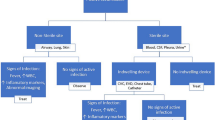Abstract
Mycobacterium chelonei infection developed at the insertion site of an indwelling Broviac catheter in a child with erythroleukemia. Direct adherence to and colonization of the intra- and extra-luminal surfaces of the catheter, with extension to the adjacent subcutaneous tissue, by this rapidly growing mycobacterium may have been the primary factor underscoring the infection. Nontuberculous mycobacteria such asMycobacterium chelonei grow readily on routine bacteriologic media and resembleCorynebacterium spp. (diphtheroids) in their Gram staining and microscopic characteristics. The persistence of the infectious process and a diphtheroid-like microorganism despite antimicrobial therapy should raise the suspicion for a mycobacterial species.
Similar content being viewed by others
References
Maki, D. G., Weise, M. S., Sarafin, H. W.: A semiquantitative culture method for identifying intravenous-catheter-related infection. New England Journal of Medicine 1977, 296: 1305–1309.
Band, J. D., Maki, D. G.: Infections caused by arterial catheters used for hemodynamic monitoring. American Journal of Medicine 1979, 67: 735–741.
Johnson, P. R., Decker, M. D., Edwards, K. M., Schaffner, W., Wright, P. F.: Frequency of Broviac catheter infections in pediatric oncology patients. Journal of Infectious Diseases 1986, 154: 570–578.
Haslett, T. M., Isenberg, H. D., Hilton, E., Tucci, V., Kay, B. G., Vellozzi, E. M.: Microbiology of indwelling central intravascular catheters. Journal of Clinical Microbiology 1988, 26: 696–701.
Hoy, J. F., Rolston, K. V., Hopfer, R. L., Bodey, G. P.:Mycobacterium fortuitum bacteremia in patients with cancer and long-term venous catheters. American Journal of Medicine 1987, 83: 213–217.
Svirbely, J. R., Buesching, W. J., Ayers, L. W., Baker, P. B., Britton, A. J.:Mycobacterium fortuitum infection of a Hickman catheter site. American Journal of Clinical Pathology 1983, 80: 733–735.
Righter, J., Hart, G. D., Howes, M.:Mycobacterium chelonei: report of a case of septicemia and review of the literature. Diagnostic Microbiology and Infectious Diseases 1983, 1: 323–329.
Repath, F., Seabury, J. H., Sanders, C. V., Domer, J.: Prosthetic valve endocarditis due toMycobacterium chelonei. Southern Medical Journal 1976, 69: 1244–1246.
Hoffman, P. C., Fraser, D. W., Robicsek, F., O'Bar, P. R., Mauney, C. U.: Two outbreaks of sternal wound infections due to organisms of theMycobacterium fortuitum complex. Journal of Infectious Diseases 1981, 143: 533–542.
Kuritsky, J. N., Bullen, M. G., Broome, C. V., Silcox, V. A., Good, R. C., Wallace, R. J.: Sternal wound infections and endocarditis due to organisms of theMycobacterium fortuitum complex. Annals of Internal Medicine 1983, 98: 938–939.
Clegg, H. W., Foster, M. T., Sanders, W. E., Baine, W. B.: Infection due to organisms of theMycobacterium fortuitum complex after augmentation mammoplasty: clinical and epidemiologic features. Journal of Infectious Diseases 1983, 147: 427–433.
Damsker, B., Bottone, E. J.: Nontuberculous mycobacteria as unsuspected agents of dermatological infections: diagnosis through microbiological parameters. Journal of Clinical Microbiology 1980, 11: 569–572.
Willett, H. P.: Mycobacterium. In: Joklik, W. K., Willett, H. P., Amos, D. B. (ed.): Zinsser microbiology. Appleton-Century-Crofts, Norwalk, CT, 1984, p. 547–581.
Sommers, H. M., Good, R. C.: Mycobacterium. In: Lennette, E. H., Balows, A., Hausler, W. J., Shadomy, H. J. (ed.): Manual of clinical microbiology. American Society for Microbiology, Washington, DC, 1985, p. 216–248.
Wallace, R. J., Swenson, J. M., Silcox, V. A., Bullen, M. G.: Treatment of nonpulmonary infections due toMycobacterium fortuitum andMycobacterium chelonei on the basis of in vitro susceptibilities. Journal of Infectious Diseases 1985, 152: 500–514.
Canilang, B., Armstrong, D.: Subcutaneous abscesses due toMycobacterium fortuitum. American Review of Respiratory Disease 1968, 97: 451–453.
Inman, P. M., Beck, A., Brown, A. E., Stanford, J. L.: Outbreak of injection abscesses due toMycobacterium abscessus. Archives of Dermatology 1969, 100: 141–147.
Gremillion, D. H., Mursch, S. B., Lerner, C. J.: Injection site abscesses caused byMycobacterium chelonei. Infection Control 1983, 4: 25–28.
Safranek, T. J., Jarvis, W. R., Carson, L. A., Cusick, L. B., Bland, L. A., Swenson, J. M., Silcox, V. A.:Mycobacterium chelonae wound infections after plastic surgery employing contaminated gentian-violet skinmarking solution. New England Journal of Medicine 1987, 317: 197–201.
Foz, A., Roy, C., Jurado, J., Arteaga, E., Ruiz, J. M., Moragas, A.:Mycobacterium chelonei iatrogenic infections. Journal of Clinical Microbiology 1978, 7: 319–321.
Cooper, J. F., Lichtenstein, M. J., Graham, B. S., Schaffner, W.:Mycobacterium chelonei: a cause of nodular skin lesions with a proclivity for renal transplant recipients. American Journal of Medicine 1989, 86: 173–177.
Author information
Authors and Affiliations
Rights and permissions
About this article
Cite this article
Engler, H.D., Hass, A., Hodes, D.S. et al. Mycobacterium chelonei infection of a Broviac catheter insertion site. Eur. J. Clin. Microbiol. Infect. Dis. 8, 521–523 (1989). https://doi.org/10.1007/BF01967471
Issue Date:
DOI: https://doi.org/10.1007/BF01967471




